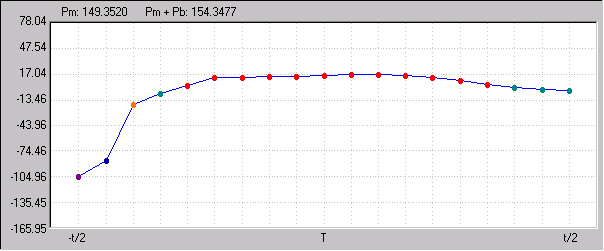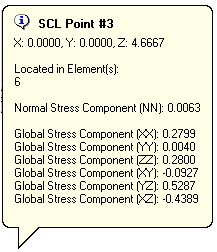Below is an image of the Graph Area. This graph will only appear after a stress classification line (SCL) has been defined using the Linearization Controls.

The SCL will be divided into segments. The stress tensor values will be calculated and output at each point. The number of points that will be defined along the line will be equal to the number of elements intersected by the SCL plus one. SCL Point #1 will be Node 1 and the last SCL Point will be Node 2. Node 1 will be at -t/2 in the graph and Node 2 will be at t/2. The origin of the local N, T, H coordinate system will be at the center of the SCL at point T. If the SCL goes through an area of space where there is no model, the points along that area will be deleted. If you hover the mouse over a point on the graph, the following pop-up information box will appear. The toolbar buttons at the left of the graph area will allow you to specify which local stress tensor to display. For information on the T, N, and H axes, see Linearization Controls. The units for the graph will depend on the unit system of your model (force/length 2 ).

This pop-up information box will tell you the global coordinates of the SCL and what elements it is located in. It will also include the local stress tensor that is currently being displayed on the graph and the six global stress tensors.
Above the graph, two additional results are listed:
- P m – This is the general primary membrane stress intensity.
- P m + P b – This is the sum of the general primary membrane stress intensity and the primary bending stress intensity.
Pm and Pb are calculated based upon the variation of the primary stress along the SCL. For more information, see the page How to Calculate Pm and Pb.
- the local N, or H axis is appropriately defined, and
- the appropriate tensor (NN, TT, HH, NT, TH, or NH) is selected for graphing.
Ideally, the graphed stress tensor should correspond with the direction of the primary membrane and bending stresses.